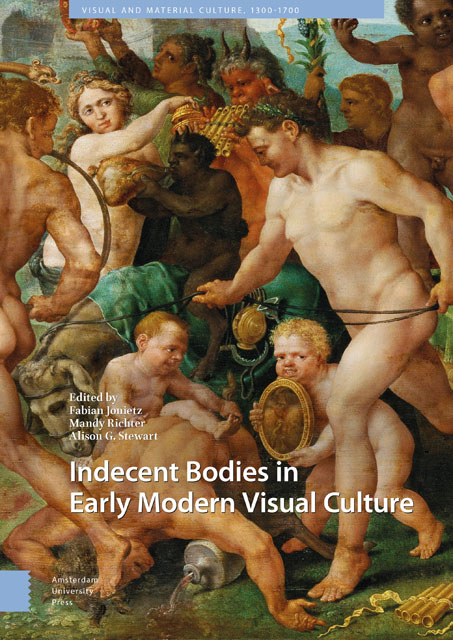Book contents
- Frontmatter
- Table of Contents
- List of Illustrations
- Indecent Bodies in Early Modern Visual Culture: An Introduction
- 1 Taste, Lust, and the Male Body: Sexual Representations in Early Sixteenth-Century Northern Europe
- 2 Private Viewings: The Frankfurt Context of Sebald Beham’s Die Nacht
- 3 To Show or Not to Show? Marcantonio Raimondi and the Representation of Female Pubic Hair
- 4 Treating Bodily Impurities: Skin, Art, and Medicine
- 5 Indecent Exposure and Honourable Uncovering in Renaissance Portraits of Women
- 6 Lust in Translation: Agency, Sexuality, and Gender Configuration in Pauwels Franck’s Allegories of Love
- 7 ‘So this guy walks into a forest…:’ obscenity, humour, sex, and the equine body in hans baldung’s Horses in a forest woodcuts (1534)
- 8 Indecent Creativity and the Tropes of Human Excreta
- 9 ‘It All Turns to Shit’ – The Land of Cockaigne in Sixteenth-Century German Woodcuts
- 10 Noëls and Bodily Fluids: The Business of Low-Country Ceremonial Fountains
- Index
1 - Taste, Lust, and the Male Body: Sexual Representations in EarlySixteenth-Century Northern Europe
Published online by Cambridge University Press: 19 April 2023
- Frontmatter
- Table of Contents
- List of Illustrations
- Indecent Bodies in Early Modern Visual Culture: An Introduction
- 1 Taste, Lust, and the Male Body: Sexual Representations in Early Sixteenth-Century Northern Europe
- 2 Private Viewings: The Frankfurt Context of Sebald Beham’s Die Nacht
- 3 To Show or Not to Show? Marcantonio Raimondi and the Representation of Female Pubic Hair
- 4 Treating Bodily Impurities: Skin, Art, and Medicine
- 5 Indecent Exposure and Honourable Uncovering in Renaissance Portraits of Women
- 6 Lust in Translation: Agency, Sexuality, and Gender Configuration in Pauwels Franck’s Allegories of Love
- 7 ‘So this guy walks into a forest…:’ obscenity, humour, sex, and the equine body in hans baldung’s Horses in a forest woodcuts (1534)
- 8 Indecent Creativity and the Tropes of Human Excreta
- 9 ‘It All Turns to Shit’ – The Land of Cockaigne in Sixteenth-Century German Woodcuts
- 10 Noëls and Bodily Fluids: The Business of Low-Country Ceremonial Fountains
- Index
Summary
Abstract
During the second quarter of the sixteenth century, Sebald Beham(1500‒1550) engraved a number of small prints with biblicallyrelated titles, Joseph and Potiphar's Wifeand Death and the Lascivious Couple. These prints,tiny enough to be held in the palm of one's hand, show themale sexually aroused. First printed in Nuremberg and later in hisnew home of Frankfurt am Main, these sexual or erotic prints werepopular enough to be copied by contemporaries and by Beham himself.This essay argues that Beham's prints and their copies arepart of a broader interest and taste for erotic imagery that wasmore widespread than previously studied, beyond Italy, and thatincluded and emphasised male erections.
Keywords: biblical subjects; erections; male arousal;printed states; Sebald Beham; sexual imagery
‘A most shameful and sinful little book, containing manyindecorous pictures of unchaste love’ (ain gannzschenndtlich und lesterlich puechlein, darynnen vylunzüchtiger gmeel von unordentlicher lieb). Letterto Augsburg's town council dated 18 June 1535 requesting thereturn of the booklet from the Nuremberg council
When Marcantonio Raimondi's I Modi hit the streets ofRome in 1524, sexually explicit imagery, like that mentioned in the unnamedbooklet above, had – without a doubt – arrived in RenaissanceEurope. Called The Positions in English, this series ofsixteen engravings after drawings by Giulio Romano depicted couples involvedin the sex act in various positions. The prints’ distribution to awider audience appears to be why Marcantonio is said to have been jailed andthe individual prints taken. Despite this confiscation, the series survivedlong enough for engraved copies to be made by Agostino Veneziano, a pupil ofMarcantonio, and as anonymous woodcuts with text printed at Venice. TheVeneziano copies, which survive today as mutilated fragments in the BritishMuseum, bear witness to the toll restrictions and changing taste paid onthis infamous Renaissance print series.
The I Modi or copies of it may have inspired theillustrations for the shameful German booklet at the opening of this essay,yet no trace of it exists today. Its title remains unknown and only a bitmore is known about the individuals involved with its publication.
- Type
- Chapter
- Information
- Indecent Bodies in Early Modern Visual Culture , pp. 39 - 64Publisher: Amsterdam University PressPrint publication year: 2022



